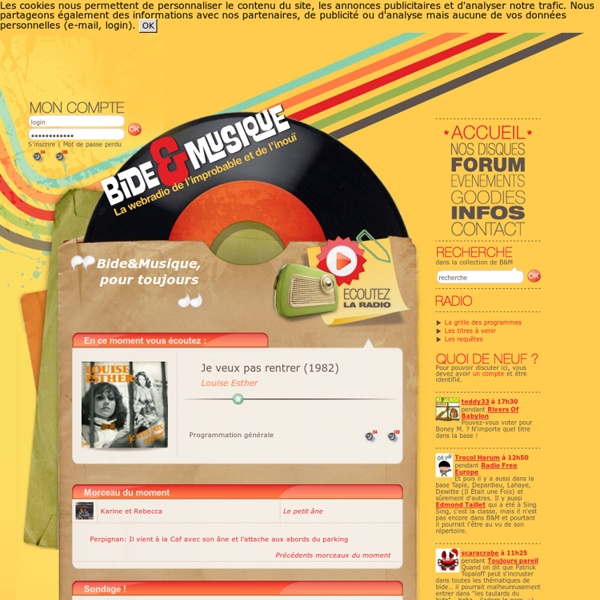



Tiger Lillies : Video Rarely seen clip of The Tiger Lillies performing the song 'Hell' on a Welsh TV show in 1995 or 1996. Featuring that bloke from 'Flying Pickets'. Martyn Jacques - Accordion/Vocals Adrian Huge - Drums Phil Butcher - Double Bass Live on RTE One The Tiger Lillies are a cult three-piece band, based in London. The Tiger Lillies on Culture Show, BBC2, Thursday 14/08/08. ABC TV Report Mark Holthusen directs The Tiger Lillies in "Living Hell" from the soon to be released album Rime of the Ancient Mariner. tiger lillies performing songs from shockheaded peter in new york. Tiger Lillies performing shockheaded peter in new york Trailer for the "Mountains of Madness" DVD by The Tiger Lillies & Alexander Hacke, a musical performance based on stories by H.P. Never seen before footage from The Tiger Lillies new show and album, 7 Deadly Sins. Roll Up!
Lyrics Mania The Invention of the White Race Infirmière chanteuse It’s what you do with Another day, another blessing Gigue du Québec L’Amour est là If You Really.mp3 I Want To Sing.mp3 La Paix.mp3 I Need To Love You.mp3 Je Veux Un Pays.mp3 Une Infirmiere.mp3 Prelude to the Irish Famine: Demographics There are no reliable population figures for Ireland before 1841, however estimates (often based on Hearth Money Returns) have been carried as far back as 1700. These figures show that Ireland's population rose slowly from around 3 million in 1700 until the last half of the 18th century when it had reached 4 million. It then entered a rapid period of increase (around 1.6% per annum) which appears to have slowed to 0.6% by 1830. By 1841, the population had reached 8.2 million (according to the census, but the actual figure may be nearer 8.5 million). The population would probably have levelled off at a value of 9 million had it not been for the famine that began in 1845. Emigration has been a feature of Irish history more than almost any other country in the world. Between 1815 and 1845, 1.5 million Irish emigrated, mainly to Britain (c0.5 million) and to north America (c1 million). > Next > The Famine 1: Potato Blight >
MC Gilles The sociological description of Ireland in Jonathan Swift’s “A Modest Proposal” Multitext - William Carleton Novelist. He was born 4 March 1794, in Prillisk, near Clogher in Co. Tyrone. His parents were small farmers and he was the youngest of fourteen children. They spoke Irish and English and had an interest in local history, story-telling, singing, and folklore. He was educated in hedge schools and he later at a classical school run by Rev. Through the Association for Discountenancing Vice, Carleton got teaching posts in Mullingar and Carlow. Carleton offered to help Robert Peel to combat Emancipation and Catholicism in Ireland and to prove that O’Connell, the Catholic Association, and the priests were involved in agrarian crime. His Traits and Stories of the Irish Peasantry is based on his knowledge of the character and folklore of the people he grew up with or met on his travels. Although Carleton was prolific and successful, he was always short of money because of his family expenses and his heavy drinking. Autobiography, Biography & Studies. Tomás O’Riordan
A History of Ireland and Her People FEATURED eBOOKS Truelove's Journal: A Bookshop Novella "Beautiful, different and touching. Short, sweet and lovely. Made me cry. Although ostensibly set in England, this story was penned by an Irish bookseller under the pseudonym of Ralph St John Featherstonehaugh. Truelove's Journal (amazon.com) ► Truelove's Journal (amazon.co.uk) ► Annals of the Famine in Ireland Annals of the Famine in Ireland, by Asenath Nicholson, still has the power to shock and sadden even though the events described are ever-receding further into the past. The ebook is available for download in .mobi (Kindle), .epub (iBooks, etc.) and .pdf formats. Ireland's Welcome to the Stranger This book, the prequel to Annals of the Famine in Ireland cannot be recommended highly enough to those interested in Irish social history. The ebook is available for download in .mobi (Kindle), .epub (iBooks, etc.) and .pdf formats. The Scotch-Irish in America You won't be inundated with emails!
Ulster-Scots History Migration back and forth across the narrow North Channel between Scotland and Ireland, which at its narrowest point (between Torr Head and the Mull of Kintyre) is only 13 miles apart, has been ongoing from time immemorial, Scotland owing its very name to Roman times and the settlement of Irish-speaking gaels in Argyle who were known as Scotti. County Antrim and County Down were essentially the majority of the Anglo-Norman Earldom of Ulster, founded by Hugh de Lacy in 1205. Walter de Burgh succeeded de Lacy and became the first Earl of Ulster in 1264. Walter was succeeded by his eldest son, Richard Og de Burgh “The Red Earl”. Richard de Burgh’s daughter Elizabeth became the second wife of King Robert the Bruce in 1302. Bruce’s father in law, the Red Earl, was the most powerful Earl in Ireland and he sided with the English King Edward I in the wars which eventually led to the Battle of Bannockburn in June 1314.